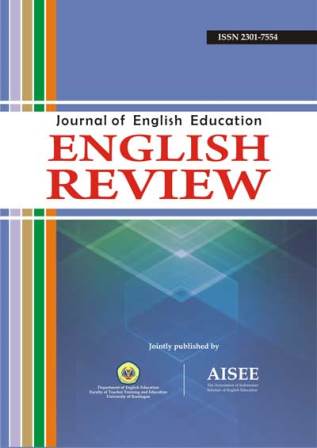A CASE STUDY OF PROSODIC PHRASAL GROUPING AND INTONATIONAL PROMINENCE IN LANGUAGE ACQUISITION
Abstract
In language acquisition, children use prosody in their comprehension and production of utterances. In line with that, as a case study in this research, I analyze two particular aspects of prosody in a child’s language acquisition, i.e. prosodic phrasal grouping and intonational prominence. In the first aspect, I investigate whether the child uses prosodic phrases to group words together into interpretable units. In the second aspect, I analyze whether the child uses intonational prominence to focus marking prosody. The result indicates that both aspects are used by the child.
Keywords: language acquisition, prosody, intonation, phonetic cues.
References
Boersma, P., & Weenink, D. (2012). Praat: Doing phonetics by computer [Computer program]. Version 5.3.24, retrieved 9 September 2013 from http://www.praat.org/.
Ito, K. (2002). The interaction of focus and lexical pitch accent in speech production and dialogue comprehension: evidence from Japanese and Basque. PhD dissertation, University of Illinois at Urbana-Champaign.
Ito, K., & Speer, S. R. (2006). Using interactive tasks to elicit natural dialogue. In Augurzky, P., and Lenertova, D. (Eds.). Methods in empirical prosody research. Leipzig: Mouton de Gruyter.
Halliday, M. A. K., & Greaves, W. S. (2008). Intonation in the Grammar of English. London: Equinox.
Johnson, E., & Jusczyk, P. W. (2001). Word segmentation by 8 month olds: when speech cues count more than statistics. Journal of Memory & Language 44(5), pp. 48 – 67.
Katz, W. F. et al. (1996). Duration and fundamental frequency correlates of phrase boundaries in productions by children and adults. Journal of the Acoustical Society of America 99, pp. 3179–3191.
Mandel, D. R., Jusczyk, P., & Pisoni, D. (1995). Infants’ recognition of the sound patterns of their own names. Psychological Science, 6, pp. 315–318.
Mehler, et al. (1988). A precursor of language acquisition in young infants. Cognition 29.143 –78.
Morgan, J. L. (1996). A rhythmic bias in preverbal speech segmentation. Journal of Memory & Language, 35, pp. 666 – 688.
Morgan, J. L., & Saffran, J. R. (1995). Emerging integration of sequential and suprasegmental information in preverbal speech segmentation. Child Development 66(9), pp. 11– 36.
Weber, A., Braun, B., & Crocker, M. W. (2006). Finding referents in time: eye-tracking evidence for the role of contrastive accents. Language and Speech 49(3), pp. 367– 92.
All articles published in English Review: Journal of English Education (ERJEE) are licensed under the Creative Commons Attribution 4.0 International License (CC BY 4.0).
Copyright Ownership
Authors retain the copyright of their articles and grant ERJEE the right of first publication. The journal is granted a non-exclusive license to publish, reproduce, and distribute the article in any format, medium, or platform, provided that proper credit is given to the original authors.
License Terms – CC BY 4.0
Under the Creative Commons Attribution 4.0 International License, others are free to:
- Share — copy and redistribute the material in any medium or format
- Adapt — remix, transform, and build upon the material for any purpose, even commercially
As long as they:
- Provide appropriate credit to the original author(s) and source
- Provide a link to the license (https://creativecommons.org/licenses/by/4.0/)
- Indicate if any changes were made
There are no restrictions on the reuse, reproduction, or adaptation of published articles as long as attribution is properly given.
Author Warranties
By submitting a manuscript to ERJEE, authors confirm that:
- The work is original and does not infringe any existing copyright.
- The manuscript has not been previously published and is not under consideration elsewhere.
- All sources and references are appropriately acknowledged.
- Necessary permissions have been obtained for any copyrighted materials used.










